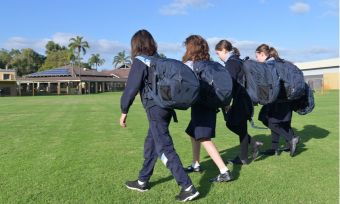Considering schools for your child? New data reveals the most expensive places in Australia to go to school. We explore average school expenses in five capital cities, and options to cover those costs.
If you’re planning to have a child, or if you already have a toddler to chase around the yard, you may be thinking about what school they will attend and how much it is going to cost to educate them. And then there’s the perennial barbecue-stopper question: Will they go to public or private school? New research suggests that this could be a wise thing to consider as early as possible, as the decisions you make could have a major impact on your household budget. There can also be long waiting lists to secure your child a preferred spot.
The Futurity Investment Group’s Planning for Education Index, released today, shows that if you choose to go down the private school route, it could cost up to four times as much as sending them to a government-run school, depending on where you live.
The Index explored the estimated costs of sending a child to school for 13 years in various parts of Australia in three different school systems – for government, Catholic and Independent schools. The Index combined the results of a survey of 1,800 people with publicly available school fee statistics, and included expenses such as school fees, outside tuition, school camps, sports equipment, uniforms and textbooks.
The Index puts the national estimated average cost of sending a child to school as:
- Government:
- Metropolitan school: $83,869
- Regional/remote school: $68,268
- Catholic:
- Metropolitan school: $143,944
- Regional/remote school: $110,370
- Independent:
- Metropolitan school: $349,404
- Regional/remote school: $143,701.
The Index also broke down the estimated costs over prep to high-school graduation for five capital cities.
The most expensive schooling costs per system across the five city capitals are:
- Government: Sydney
- Catholic: Brisbane
- Independent: Sydney.
The cheapest:
- Government: Brisbane
- Catholic: Sydney
- Independent: Perth.
Average schooling costs in Australia
The costs for sending one child to Australian government, Catholic or Independent school from prep to Year 12 are shown below:
The estimated total costs of schooling for an Australian child are shown below, with the data comparing the education costs across selected cities and regional and rural areas nationally.
And, to really put the pressure on, Futurity Group Executive Kate Hill said the research also found that 39% of private schools are likely to increase school fees this year. More generally, the cost of education has risen at more than double the rate of inflation over the past decade.
Canstar money expert Effie Zahos said while seeing the total possible education expenses presented in a lump-sum figure could be confronting to some parents, it was important to remember the financial impact was not usually felt all at once. School fees for private schools can often be paid in regular installments over the course of the year, depending on a school’s policy.
“It’s the old adage that comes into play here: ‘It pays to be prepared’,” Ms Zahos said.
“And while some of us have kids unexpectedly, and everyone knows having a child can throw a spanner in the budgeting works, there are fortunately a few things that parents can do to cushion the financial blow if they really want to send their kids to private school.”
How can you finance the cost of education?
Ms Zahos said options to fund education costs include:
- Savings: If you have enough time and resources, create a budget that includes a long-term savings plan. A little bit put away on a regular basis can really add up over time. You could power up those savings by putting them in an offset account on a home loan, which could also help to reduce the amount of interest that you have to pay on your mortgage. And there is always the option of traditional term deposit accounts (when interest rates on these start heading up again).
Explore: Best term deposit rates on Canstar’s database
- Education bond: You could consider an education bond, which is a form of an insurance bond, that could provide potential tax benefits and help to cover expenses over time. With these, Ms Zahos said, it was best to obtain advice and read the terms and conditions carefully before making a decision.
- EFT: An Exchange Traded Fund (EFT) allows you to invest in a managed fund that invests in shares.
Ms Zahos said that as with all important financial decisions, it could also be a good idea to seek the advice of a suitably qualified professional.
How much do you have to save per month to cover a child’s education costs?
Looking at the national average estimated schooling costs for the three systems, Apt Wealth Partners analysed how much a household may have to set aside per month for different funding options, with the figures shown below.
Ms Zahos said an obvious way to save money on schooling costs could be to select a government-run school, which did not charge fees. And there were also a number of government schemes, subsidies and rebates that could help eligible families cover ancillary education costs like uniforms.
“It really comes down to taking a look at what’s best for your family and your child – that’s the most important thing,” she said. “It might be a case of really considering the situation and resetting the goal posts. If you really do want your child to go to a private school, maybe that is just high school.”
However, there could be unexpected barriers to entering public schools, too, especially when it comes to securing a seat in certain high-performing government schools.
“This is why the price of houses in the catchment area of a good public school can skyrocket, as parents try to gain automatic entry for their children,” Ms Zahos said.
“But don’t forget, catchment zones can change over time.”
Explore: What are school catchment areas?
This content was reviewed by Sub Editor Jacqueline Belesky as part of our fact-checking process.






Share this article